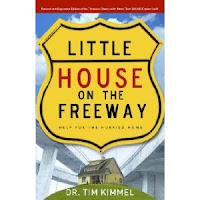 Little House on the Freeway - Help for the Hurried Home by Dr. Tim Kimmel. I finished reading this book on Saturday night while the kids enjoyed playing in the bathtub. It's a good thing I did because Sunday, Monday and Tuesday were so busy and scheduled that I would not have had time to finish reading it before I was supposed to post this review. Did I need to read this book? Yes! Actually the copy I have is about four years old and has different cover art. I picked it up at a marriage retreat that my husband and I went to when our oldest was just over two. Pretty funny that we both felt so busy and over-scheduled then. Two kids and many new commitments later sometimes I wonder how long we're going to be able to keep this house and its occupants rolling down the freeway. I think this is a fairly common feeling for parents of special needs children. We have all the normal pressures of life: housework, child care, shopping, working, and trying to stay healthy. Add in researching/applying for/driving to therapy sessions, extra meetings at school, extra attention needed for behavioral supports, always one more technique to try, and paperwork, and that's assuming the special needs child doesn't have medical issues. For those of us who pursue a life of faith you can add personal devotions, and church commitments. No wonder I often feel like I'm running the wrong way up an endless escalator.
Little House on the Freeway - Help for the Hurried Home by Dr. Tim Kimmel. I finished reading this book on Saturday night while the kids enjoyed playing in the bathtub. It's a good thing I did because Sunday, Monday and Tuesday were so busy and scheduled that I would not have had time to finish reading it before I was supposed to post this review. Did I need to read this book? Yes! Actually the copy I have is about four years old and has different cover art. I picked it up at a marriage retreat that my husband and I went to when our oldest was just over two. Pretty funny that we both felt so busy and over-scheduled then. Two kids and many new commitments later sometimes I wonder how long we're going to be able to keep this house and its occupants rolling down the freeway. I think this is a fairly common feeling for parents of special needs children. We have all the normal pressures of life: housework, child care, shopping, working, and trying to stay healthy. Add in researching/applying for/driving to therapy sessions, extra meetings at school, extra attention needed for behavioral supports, always one more technique to try, and paperwork, and that's assuming the special needs child doesn't have medical issues. For those of us who pursue a life of faith you can add personal devotions, and church commitments. No wonder I often feel like I'm running the wrong way up an endless escalator.Interestingly Dr. Kimmel's answer isn't just: "Slow down, silly!" He breaks down inner attitudes that are needed to find true rest, things like forgiveness, a sense of eternity, service, and knowing your gifts. Dr. Kimmel also includes some practical applications for how to bring an attitude of rest to your marriage, your kids, your work, and your other relationships. At the end of the book there is a list of 101 ways to give rest to your family. Some are big (pay off your credit cards - yikes!), some are small (take a walk as a family.) Some are long term (religiously wear your seat belts) some are short term (replace the batteries in your smoke alarm). I really like all of the things that are balanced in this book. There are times when Dr. Kimmel uses a soft touch to make his point and other times where he says, "I know this isn't easy to read, but this is what you need to do..." There are some truly poignant stories used to illustrate his point and others that will make you laugh out loud. Do you like practical tips? There in there. Do you want a more philosophical approach to the idea of rest? Got it. I was particularly blessed by the chapter where Dr. Kimmel describes holding his daughter in the NICU all night as she struggled with apnea. I have a feeling he can relate to special needs parents.
End result: obviously my daily schedule hasn't slowed down a bit. (Is someone fiddling with the speed on that escalator again??) But this book, combined with a renewed commitment to address my own physical health needs, seems to have provided a new sense of focus and calm. When the to do list is too long the most important things are still getting done, and I find it easier to let the other items go.
Rest up, friends, it is a long road!



